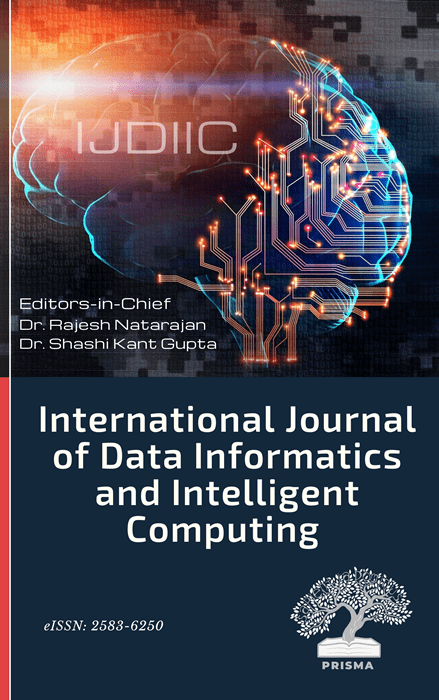A Big Data Analytical Framework for Intrusion Detection Based On Novel Elephant Herding Optimized Finite Dirichlet Mixture Models
DOI:
https://doi.org/10.59461/ijdiic.v2i2.58Keywords:
Big Data , Cybersecurity , Intrusion Detection System (IDS), Elephant Herding Optimized , Finite Dirichlet Mixture Models (EHO-FDMM)Abstract
For the purpose of identifying a wide variety of hostile activity in cyberspace, an Intrusion Detection System (IDS) is a crucial instrument. However, traditional IDSs have limitations in detecting zero-day attacks, which can lead to high false alarm rates. To address this issue, it is crucial to integrate the monitoring and analysis of network data with decision-making methods that can identify anomalous events accurately. By combining these approaches, organizations can develop more effective cybersecurity measures and better protect their networks from cyber threats. In this study, we proposed a novel called the Elephant Herding Optimized Finite Dirichlet Mixture Model (EHO-FDMM). This framework consists of three modules: capture and logging, pre-processing, and an innovative IDS method based on the EHO-FDMM. The NSL-KDD and UNSW-NB15 datasets are used to assess this framework's performance. The empirical findings show that selecting the optimum model that accurately fits the network data is aided by statistical analysis of the data. The EHO-FDMM-based intrusion detection method also offers a lower False Alarm Rate (FPR) and greater Detection Rate (DR) than the other three strong methods. The EHO-FDMM and exact interval of confidence bounds were used to create the suggested method's ability to detect even minute variations between legal and attack routes. These methods are based on correlations and proximity measurements, which are ineffective against contemporary assaults that imitate everyday actions.
Downloads
References
P. Tyagi and S. K. Manju Bargavi, “Using Federated Artificial Intelligence System of Intrusion Detection for IoT Healthcare System Based on Blockchain,” Int. J. Data Informatics Intell. Comput., vol. 2, no. 1, pp. 1–10, Mar. 2023, doi: 10.59461/ijdiic.v2i1.42.
Z. Ahmad, A. Shahid Khan, C. Wai Shiang, J. Abdullah, and F. Ahmad, “Network intrusion detection system: A systematic study of machine learning and deep learning approaches,” Trans. Emerg. Telecommun. Technol., vol. 32, no. 1, Jan. 2021, doi: 10.1002/ett.4150.
H. Liu and B. Lang, “Machine Learning and Deep Learning Methods for Intrusion Detection Systems: A Survey,” Appl. Sci., vol. 9, no. 20, p. 4396, Oct. 2019, doi: 10.3390/app9204396.
A. Khraisat, I. Gondal, P. Vamplew, and J. Kamruzzaman, “Survey of intrusion detection systems: techniques, datasets and challenges,” Cybersecurity, vol. 2, no. 1, p. 20, Dec. 2019, doi: 10.1186/s42400-019-0038-7.
F. H. Almasoudy, W. L. Al-Yaseen, and A. K. Idrees, “Differential Evolution Wrapper Feature Selection for Intrusion Detection System,” Procedia Comput. Sci., vol. 167, pp. 1230–1239, 2020, doi: 10.1016/j.procs.2020.03.438.
C. Ieracitano, A. Adeel, F. C. Morabito, and A. Hussain, “A novel statistical analysis and autoencoder driven intelligent intrusion detection approach,” Neurocomputing, vol. 387, pp. 51–62, Apr. 2020, doi: 10.1016/j.neucom.2019.11.016.
G. Marín, P. Caasas, and G. Capdehourat, “DeepMAL - Deep Learning Models for Malware Traffic Detection and Classification,” in Data Science – Analytics and Applications, Wiesbaden: Springer Fachmedien Wiesbaden, 2021, pp. 105–112. doi: 10.1007/978-3-658-32182-6_16.
F. Martinez-Plumed et al., “CRISP-DM Twenty Years Later: From Data Mining Processes to Data Science Trajectories,” IEEE Trans. Knowl. Data Eng., vol. 33, no. 8, pp. 3048–3061, Aug. 2021, doi: 10.1109/TKDE.2019.2962680.
M. Seyedan and F. Mafakheri, “Predictive big data analytics for supply chain demand forecasting: methods, applications, and research opportunities,” J. Big Data, vol. 7, no. 1, p. 53, Dec. 2020, doi: 10.1186/s40537-020-00329-2.
S. U. Jan, S. Ahmed, V. Shakhov, and I. Koo, “Toward a Lightweight Intrusion Detection System for the Internet of Things,” IEEE Access, vol. 7, pp. 42450–42471, 2019, doi: 10.1109/ACCESS.2019.2907965.
S. B and M. K, “Firefly algorithm based feature selection for network intrusion detection,” Comput. Secur., vol. 81, pp. 148–155, Mar. 2019, doi: 10.1016/j.cose.2018.11.005.
M. Eskandari, Z. H. Janjua, M. Vecchio, and F. Antonelli, “Passban IDS: An Intelligent Anomaly-Based Intrusion Detection System for IoT Edge Devices,” IEEE Internet Things J., vol. 7, no. 8, pp. 6882–6897, Aug. 2020, doi: 10.1109/JIOT.2020.2970501.
M. Almiani, A. AbuGhazleh, A. Al-Rahayfeh, S. Atiewi, and A. Razaque, “Deep recurrent neural network for IoT intrusion detection system,” Simul. Model. Pract. Theory, vol. 101, p. 102031, May 2020, doi: 10.1016/j.simpat.2019.102031.
Y. Zhou, G. Cheng, S. Jiang, and M. Dai, “Building an efficient intrusion detection system based on feature selection and ensemble classifier,” Comput. Networks, vol. 174, p. 107247, Jun. 2020, doi: 10.1016/j.comnet.2020.107247.
X. Zhou, Y. Hu, W. Liang, J. Ma, and Q. Jin, “Variational LSTM Enhanced Anomaly Detection for Industrial Big Data,” IEEE Trans. Ind. Informatics, vol. 17, no. 5, pp. 3469–3477, May 2021, doi: 10.1109/TII.2020.3022432.
N. Moustafa and J. Slay, “The evaluation of Network Anomaly Detection Systems: Statistical analysis of the UNSW-NB15 data set and the comparison with the KDD99 data set,” Inf. Secur. J. A Glob. Perspect., vol. 25, no. 1–3, pp. 18–31, Apr. 2016, doi: 10.1080/19393555.2015.1125974.
M. Yan, Y. Chen, X. Hu, D. Cheng, Y. Chen, and J. Du, “Intrusion detection based on improved density peak clustering for imbalanced data on sensor-cloud systems,” J. Syst. Archit., vol. 118, p. 102212, Sep. 2021, doi: 10.1016/j.sysarc.2021.102212.
D. Crow, S. Graham, B. Borghetti, and P. Sweeney, “Engaging Empirical Dynamic Modeling to Detect Intrusions in Cyber-Physical Systems,” 2020, pp. 111–133. doi: 10.1007/978-3-030-62840-6_6.
Zhiyuan Tan, A. Jamdagni, Xiangjian He, P. Nanda, and Ren Ping Liu, “A System for Denial-of-Service Attack Detection Based on Multivariate Correlation Analysis,” IEEE Trans. Parallel Distrib. Syst., vol. 25, no. 2, pp. 447–456, Feb. 2014, doi: 10.1109/TPDS.2013.146.
Downloads
Published
How to Cite
Issue
Section
License
Copyright (c) 2023 V. Suresh Kumar

This work is licensed under a Creative Commons Attribution-ShareAlike 4.0 International License.








